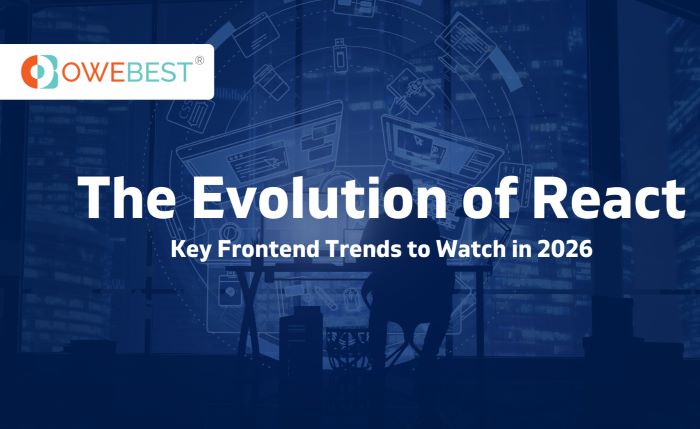In 2026, React.js is not just in survival mode; it is fundamentally changing the whole concept of how different modern web applications are developed. It is setting some new standards for an efficient developer’s experience and shaping key frontend trends across the industry. Furthermore, the main reason for React’s resilience lies in its ecosystem’s ability to evolve and also embrace radical changes. React is also the prime driving engine of this unification. According to Stack Overflow’s annual developer survey, React continues to be the most used and popular web development technology by 44.7%.
In this guide, we will discuss why hiring React.js developers is the best choice. We will provide an in-depth exploration of the latest React.js development trends and best practices that companies use to create powerful, future-ready digital experiences.
Key Takeaways
- In 2026, React.js continues to revolutionize web application development with innovative frontend trends.
- Key trends include the shift to Server Components, AI-augmented workflows, and a focus on framework-centric development.
- Modern state management using TanStack Query and Micro-Frontend architecture enhances scalability and efficiency.
- Future predictions highlight AI-native applications, deeper integration with WebAssembly, and improved concurrency and streaming capabilities.
- Hiring React.js developers ensures businesses stay at the forefront of these evolving frontend trends.
Table of Contents
Top React.js Development Trends Agencies Are Using in 2026
Most of the top React JS development frontend trends agencies’ list is not merely using React. Instead, they mainly keep their prime focus on how they use the technology. The following trends also represent a cutting-edge development. They focus on better performance, scale, and greater efficiency. Here are the Top 5 React.js development trends to look for when you hire ReactJS developers.
1. Shift to Server Components (RSC)
The shift to server components is considered one of the most transformative frontend trends in the React world.
React Server Components also allow developers to render multiple components entirely on the server before any JavaScript is sent to the browser. However, the result is pure CSS and HTML that are delivered initially. This drastic change also improves the crucial First Contentful Paint and overall load times.
2. AI-Augmented Workflows
Artificial Intelligence is also considered a direct partner in the code editor. And, integrating AI coding assistants, for example, Copilot or specialized in-house tools, into the development environment makes the work easy. An AI app development company also follows these. These tools are used for:
- Drafting initial unit and integration tests; thus, free up the developers to focus on some complex logic.
- Proactively spotting some security flaws and performance bottlenecks during the writing process.
- Instantly creating significant hooks and different components based on simple text prompts.
This trend significantly enhances the overall efficiency of the AI software development service.

3. Framework-Centric Development
Agencies now use some powerful meta-frameworks, for example, Next.js and Remix. These tools also offer a complete architectural solution out of the box, covering everything a modern web app needs:
- Advanced routing
- Multiple rendering strategies
- API routes and server functions
This not only streamlines development, but also allows the team to focus purely on some ideal business logic rather than configuration.
4. Modern State Management
Agencies now prefer to opt for lighter and more intuitive global state solutions, and this requires minimal setup and code.
Crucially, they also use TanStack Query to manage the overall server state. This clear separation between the UI state and server state greatly simplifies multiple applications.
5. Micro-Frontend Architecture
Using React to build some independent and composable parts of a single application is known as Micro-Frontends. This not only allows the large agencies to assign different feature teams to separate some codebases. These can be easily built, tested, and deployed independently.
This strategy minimizes dependencies between teams and allows for true scaling of development efforts.
Predictions for the Future of React Development
Several key frontend trends and predictions ensure the future of React development. These trends include –
● AI-Native Application Focus
The rise of some Large Language Models (LLMs) and Generative AI tools brings a new demand for sophisticated frontends. While the React.js agencies’ trends indicate a significant shift towards building some complex conversational and data-visualization interfaces, those are specifically designed for interacting with AI models. An AI app development company can help you the best in this case.
React, with its component-based model and flexibility, is perfectly positioned to become the primary tool for developing some intuitive, chat-based, as well as analytical AI frontend trends. For organizations looking to build such interfaces, it’s becoming increasingly important to hire reliable React developers. They should already have experience in the exclusive AI-integrated frontends. Companies operating at the intersection of design, AI, and engineering are great examples of this evolving approach.
● Deeper Integration with WebAssembly (WASM)
WebAssembly is mainly known for powering some specialized, high-speed features, even though most developers rarely use it directly for different apps. Furthermore, Wasm is on track to become a behind-the-scenes powerhouse. It is quietly boosting everyday libraries and tools.
Similarly, opening a React app and interacting with a data grid effortlessly filters and even sorts a massive amount of data in a blink. This is why an AI app development company uses this while developing the apps. Furthermore, React here serves as the coordination layer. It makes the Wasm’s performance universally accessible for some data-heavy applications.
● Further Concurrency & Streaming Adoption
React’s foundational features are also excellent for ensuring improved user experience (UI), like Suspense and Concurrent Mode. These modes turn out to be much stable to ensure that the ReactJS developers can easily build non-blocking UIs. The data fetching, rendering delays, and state updates are handled gracefully.
When you hire ReactJS developers, users can see content streamed onto the page as it becomes highly accessible. This creates a smooth and uninterrupted browsing experience.
● React Native’s New Architecture
React has been a top choice of many businesses and agencies aiming to deliver compelling digital experiences. The reason behind this is that React is extending beyond web development. However, for agencies, React is offering cross-platform mobile services. The adoption of React Native’s new architecture has turned out to be a game-changer.
This new foundation offers some improved performance, better type safety, as well as deeper and flawless integration with native platform specifics. These significantly drive enterprise mobile adoption. They ensure React’s position as the leading choice for both web and mobile.
Conclusion
React’s evolution is not just about bringing the library changes. Rather, it is about how digital experiences are imagined, built, optimized, and even scaled. However, the difference between an intelligent application and an outdated one has never been more evident. So, brands that hire ReactJS developers can experience AI-first thinking and performance-led engineering practices. These enhance the ReactJS landscape in 2026 and beyond.
So, want to stay ahead of the curve? Then, it’s time to connect to the right AI app development company. Adopt cutting-edge workflows, besides building frontend trends and systems that design apps for tomorrow.











